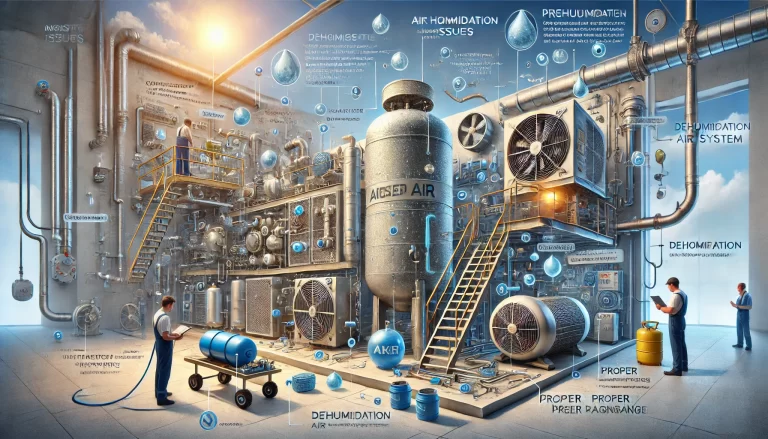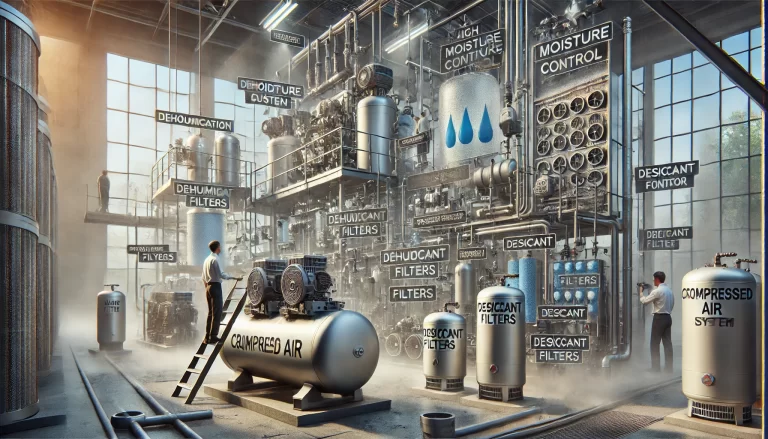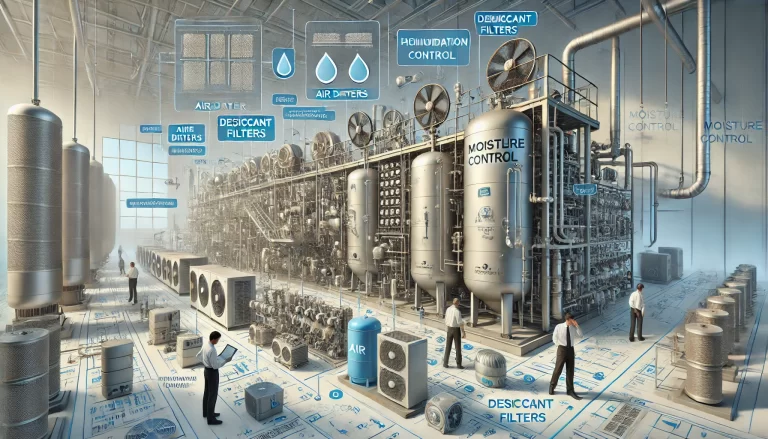Introduction
Compressed air is a crucial energy source and control medium widely used in industrial, transportation, construction, medical, and other sectors. One key factor that impacts the quality and stability of compressed air is its moisture content. Excessive moisture can lead to equipment malfunctions, compromised product quality, increased energy consumption, and higher production costs. This article examines the main causes of high moisture levels in compressed air systems and provides detailed solutions to address each cause.
Analysis of Causes for High Moisture Content in Compressed Air
External Air Humidity
The moisture in compressed air primarily originates from the external environment. In areas or seasons with high humidity, the air intake of a compressor can bring in significant water vapor, leading to elevated moisture content in the compressed air. For example, facilities in tropical climates often experience moisture issues more frequently.
Solution: To mitigate this effect, installing dehumidification equipment in the air intake system can reduce the moisture entering the compressor. This can be achieved by adding desiccant air dryers or refrigeration air dryers to the system. In extremely humid areas, specialized intake air filters may be required to lower the initial humidity level.

2. Malfunction of Air Treatment Equipment
Compressed air systems often include filters, dryers, and coolers that remove moisture, oil, and other contaminants. If any of these components malfunction, they can fail to remove adequate moisture, causing an increase in the overall moisture content. Common issues include clogged filters, malfunctioning dryers, or insufficient cooling capacity.
Example: A clogged filter in the system could restrict airflow, causing backpressure and reducing the system’s efficiency, ultimately allowing more moisture to bypass the drying process.
Solution: Regular maintenance and inspection of air treatment equipment are essential. Establishing a preventive maintenance schedule can help detect issues early, ensuring that all components are working optimally. When malfunctions are identified, prompt repairs or replacements should be conducted.
3. Heat Generated During Compression
The compression process generates substantial heat, which can cause water vapor in the air to remain in a gaseous state instead of condensing, leading to higher moisture levels in the compressed air. This effect is particularly noticeable in high-temperature environments or when the compressor operates continuously.
Solution: Choosing high-efficiency compressors with lower heat output can help. Additionally, integrating an aftercooler in the system can reduce the air temperature immediately after compression, allowing water vapor to condense before entering the distribution lines.
4. Ineffective Cooling System
An inadequate cooling system can prevent effective condensation and separation of water vapor, resulting in high moisture levels in the compressed air. This issue is often observed when the cooling system capacity is undersized relative to the compressor’s output or when the system is clogged or damaged.
Example: A cooler with insufficient capacity will struggle to bring the air temperature down to dew point levels, allowing more water vapor to remain in the air.
Solution: Upgrading the cooling system to match the compressor’s capacity can significantly reduce moisture content. Regular cleaning and checking of cooling components, such as heat exchangers and fans, will ensure they function correctly. In larger installations, a chiller may be added to manage temperatures more effectively.
5. Inadequate Drainage System
Compressed air systems typically include drainage to remove accumulated moisture. However, if the drainage system is faulty—due to blocked drain pipes, faulty drain valves, or inadequate draining frequency—water can remain in the system, raising moisture content levels.
Solution: Conduct regular inspections and clean the drainage components as necessary. Automated drains, which operate at set intervals, can help maintain consistent water removal, reducing the chance of water accumulating in the system.

6. Improper Pipeline and Storage Design
The design and layout of pipelines and storage tanks are critical for efficient moisture control. Complex or poorly inclined piping layouts can lead to water accumulation. Additionally, storage tanks that are not appropriately sized can increase moisture levels.
Example: If the pipes do not have a slope or lack sufficient drainage points, water can collect in low areas, leading to increased moisture levels in the air that passes through these points.
Solution: When designing or upgrading a compressed air system, ensure that the pipelines are inclined for efficient water drainage. Install drainage points at regular intervals, particularly in low points of the system, to facilitate water removal. In storage tanks, consider adding water traps to minimize moisture buildup.
7. Mismatch Between Compressor Model and Application Requirements
The choice of compressor significantly impacts the moisture level in the compressed air. Using a compressor model that is not suited to the environmental or operational conditions can lead to excessive moisture. Different compressors have varying capabilities for moisture removal, cooling efficiency, and drainage design.
Solution: Consult with compressor manufacturers or industry experts when selecting equipment to ensure that the model chosen matches the specific operational needs. Factors to consider include ambient temperature, required pressure levels, and the system’s moisture tolerance. Proper matching can enhance the performance and longevity of the system.

Solutions for Reducing Moisture in Compressed Air
Installation of Drying Equipment
Using a combination of aftercoolers, air tanks, separators, and dryers can effectively reduce moisture. Installing drying equipment, such as refrigerated air dryers or desiccant dryers, will condense water vapor, removing it from the air before it reaches critical points in the system. For high-humidity environments, advanced desiccant drying systems are recommended.
Enhanced Cooling System
Improving the compressor’s cooling system can control air temperature and reduce moisture. Upgrading the cooling capacity or adding supplementary cooling devices can effectively condense and separate water vapor before it circulates in the system.
Regular Maintenance and Drainage Checks
Scheduled maintenance of drainage systems is vital to ensuring effective water removal. Automated drains, properly adjusted for optimal frequency, can consistently remove moisture, preventing its accumulation. This routine also includes checking and replacing filters as needed to maintain peak efficiency.
Optimizing Pipeline and Storage Tank Design
Ensure that the design of pipelines and storage tanks promotes smooth airflow and minimizes water accumulation. Adding additional drainage points in pipelines and incorporating water traps in storage tanks can significantly reduce residual moisture.
Selecting the Right Compressor Model
Choosing the appropriate compressor model, designed for the specific operating environment and moisture requirements, can greatly reduce moisture issues. When selecting a model, consider factors such as dehumidification capacity, cooling efficiency, and drainage capabilities.

Conclusion
High moisture content in compressed air is a multifaceted issue influenced by external humidity, equipment performance, system design, and operational choices. By understanding the root causes and implementing tailored solutions, it is possible to significantly reduce moisture levels, improve compressed air quality, and enhance system stability.
